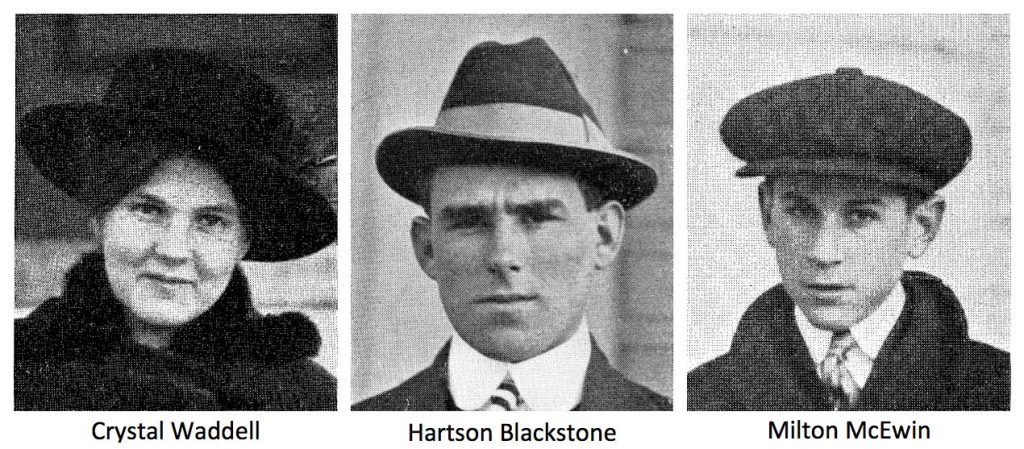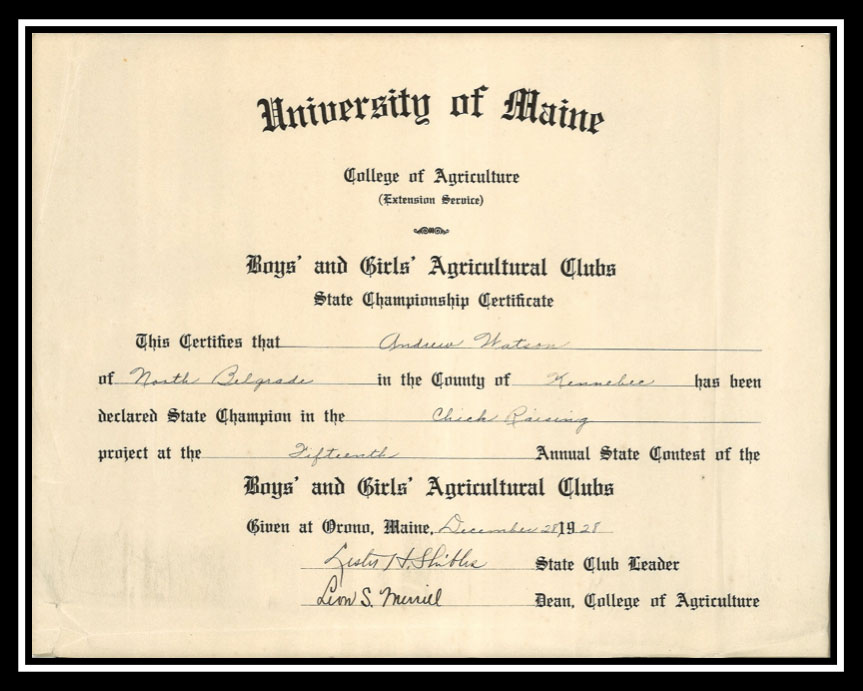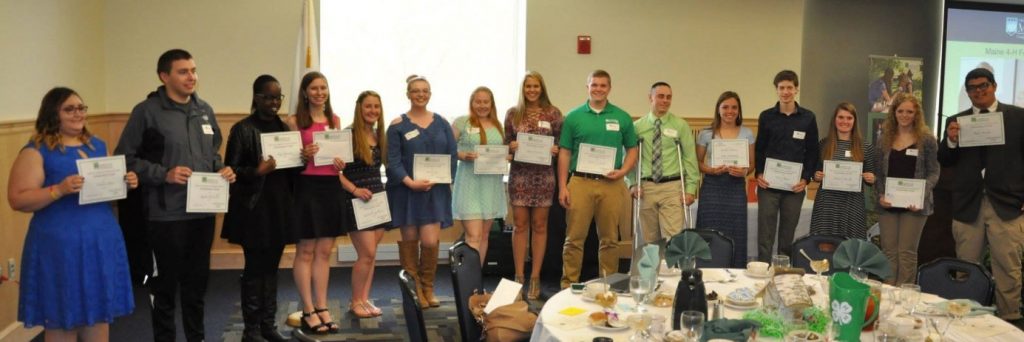4-H Fix: Champions!
CHAMPIONS!
By Ron Drum, Statewide 4-H Program Professional/Associate Director 4-H Resource Development
Let’s face it. Who doesn’t like a CHAMPION?! Some would even argue that there is nothing better than being a CHAMPION! From personal experience I can tell you it is some fun!
Yes, I was once a champion! It was 1969 and I somehow was able to get my Soap Box Derby Racer across the finish line ahead of all my competitors making me the Hazelton Area Soap Box Derby Class B Champion (ages 10-12) of 1969! They said that, comparing the heat times, I’d have beaten the Class A Champion (for ages 13-15), too, except I kind of got over-excited winning the Class B Championship, hit my breaks too hard, spun out, crashed, and broke my axle (my mom was glad it wasn’t my leg!). Since I couldn’t race in the overall championship heat, Bruce (the Class A Champion) got to go to the National Soap Box Derby in Akron, Ohio. He lost to a kid from Texas. Darn.
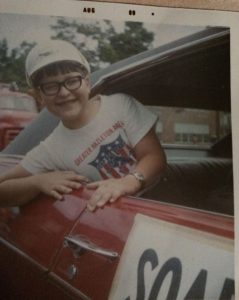 Still, I got to ride in the Champions’ Car in the Hazleton Area Soap Box Derby Parade (the people cheered; Mom and Dad were the loudest) and get interviewed on radio and on TV, and lots of “ink” in the Hazelton Standard-Speaker newspaper. I even got to raise my trophy into the air!
Still, I got to ride in the Champions’ Car in the Hazleton Area Soap Box Derby Parade (the people cheered; Mom and Dad were the loudest) and get interviewed on radio and on TV, and lots of “ink” in the Hazelton Standard-Speaker newspaper. I even got to raise my trophy into the air!
We see it all the time! Lombardi Trophies get raised in the air, sometimes even KISSED, at the end of Super Bowl Games! Basketball players cut down the nets, which, by the way, always worries me that someone is going to get hurt because it looks a bit dangerous to me when they are doing it. They used to rush the football field and tear down the goal posts too, which WAS dangerous and people DID get hurt which is why, I think, they stopped doing that; not to mention the cost of replacing it! The boxer’s gloved fist gets raised above his head! The Blanket of Roses gets laid on the horse’s back. The gold medal is hung around the Olympian’s neck!
And the word “CHAMPION” gets attached to the name.
So, it should follow, obviously, that 4-H should have its champions, too! Right? Right!
The job of Extension has always been to teach the newest methods and understandings achieved through academic research to the people who can best use the knowledge, we the citizens! However, we the citizens are a resistant lot! The adults didn’t want to accept the new ideas and methods but the children did! Teaching to groups of young people was more efficient than teaching individuals so youth clubs were formed. Here again that resistance appeared! I’m not sure I understand why but people were suspicious of, and therefore resistant to, this new idea of club work! The Extension staff needed a way to show the people that club work was a good thing.
So, at the end of the first full year of 4-H in Maine, 1914, they held a State Contest of highest achieving county 4-H’ers and picked one as the Overall State Winner, to help make this point. That worked so well that counties began to hold their own contests to show the benefits of club work. These contests, sort of like fairs, sometimes called exhibitions, brought together all the county’s club members to show their project work and to see who was the best. Those county winners were then named County Champions!
The next logical step, with all these county champions being identified, was to bring the county champions to the already established state contest and have them compete with each other to see who would be the “champion” of each project area! So, the County Champions were sent to the State 4‑H Contest, usually held the last week of December on the Orono Campus of the University of Maine, and the competitions began.
And the Champions were chosen!
Being a 4-H Champion was a BIG deal, County or State; a badge of HONOR! Noted in a previous post, “the Original 4-H Brownie,” when Mildred Brown was introduced to the Extension Community in 1925 as the new Assistant State 4-H Leader by State 4-H Leader Lester Shibles, he made a point to mention that she twice earned the title of Kennebec County 4‑H Canning Champion and had placed third at a State Contest.
So the way it worked, at the State Contest at least, was the club members brought examples of their project work (for example, in the case of the Canning project, the members had to exhibit 10 jars of fruits and vegetables) to be judged by University officials. The exhibit scores became 20% of the overall score. The members had to submit a written story to be judged, which also was worth 20% of the score. Since one of the “selling” points for doing club work was that money could be earned through the project, the profit earned on the project made up 30% of the score and “production” was the final 30% of the score.
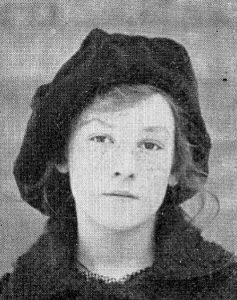
The first “Club Work State Winner” designated during the first State Contest held in 1914 was a 10-year old Washington County canning club member named Emily Morse of Cherryfield. Her story was told in a previous post called “She Set the Bar High.” She just missed being designated as “Champion” in 1915 but was anointed Champion in 1916 and 1917, then just missed again in 1918, making her quite the celebrity in the first five years of Maine 4-H, or “Club Work” as it was then known!
Penobscot County’s Marion Griffin of Levant was the Canning Champ to beat Emily in 1918. It was Aroostook County’s twelve year old Crystal Waddell of Mapleton who edged Emily out in 1915. Crystal’s two fellow Champions that year were Aroostook County’s Hartson Blackstone of Perham, Potato Champion, and Sagadahoc County’s Milton McEwin of Bowdoinham, Poultry Champion. I suppose there would have been more champions in 1915 if there had been more projects carried. However, those were the only three projects carried in 1915.
According to the 1916 UMaine Extension Bulletin #100 (Club Work Series #2), Hartson raised 459 bushels of potatoes to the acre in 1915, at a cost of 17 cents to the bushel (they don’t say how many acres). Crystal “put up 158 quarts of pickled beets” and sold 13 bushels of fresh beets. Milton won first prize at the Topsham Fair for his pen of Rhode Island Reds. He sold the pen’s rooster as a breeder for $10.00. Now those are indeed some championship stats!
According to a story on page 5 of the December 30, 1916 edition of the Bar Harbor Times, 1916 Canning Champion Emily was joined by fellow Champions Alma Davis, Machias, Poultry; Dorothy Shackford, Ellsworth, Pig Raising; Milford Blackstone, Perham, Potato Raising; and Hilda Sullivan, Orono, Gardening.
Milford was Hartson’s younger brother. I’m not sure what the age range was to be a Club Member when this all started (it’s 5-19 now) so I’m guessing Hartson, being 20 years old in 1916, was too old to compete, opening the door for 18-year-old Milford. Either that or it was a hard fought battle between brothers!
 Hartson continued farming in Perham and his family stayed in association with 4-H. Extension Bulletin #228: Boys’ and Girls’ 4-H Clubs in Maine, written by Extension Editor Clarence Day in 1936, included this photo of Hartson, then age 40, and his two 4-H Member sons, 16 year old Philip and 14 year old Richard.
Hartson continued farming in Perham and his family stayed in association with 4-H. Extension Bulletin #228: Boys’ and Girls’ 4-H Clubs in Maine, written by Extension Editor Clarence Day in 1936, included this photo of Hartson, then age 40, and his two 4-H Member sons, 16 year old Philip and 14 year old Richard.
Hartson is the fellow in the middle. Hartson and his wife Kathryn, also age 40 in 1936, had a total of five children. Ruth, born 1926, Hartson, born 1928, and Mary, born 1930, round out the family.
As the number of 4-H Projects one could take in 4-H increased each year, so too grew the number of State Champions.
The 16th Annual State 4-H Contest, held in 1929, was regarded by many as one of the best ever held. That year saw eleven 4-H Members be named to twelve Championships; Wayne Rich of Charleston was named Champion in both Pig Raising and Potato Raising. Rich went on to have a highly successful career with Extension. Serving for a year (1934-35) as Assistant Extension Editor, he helped launch Maine Extension’s foray into teaching via radio in 1935! Rich served for a number of years as the Androscoggin/Sagadahoc County 4-H Agent before he moved to New Hampshire where he finished his Extension career. The Maine 4-H Foundation’s Wayne S. Rich 4-H Scholarship is named in his memory.
Wayne’s fellow 1929 champions were Andrew Watson, North Belgrade, Chick Raising; Helen Goodwin, Shapleigh, Beans; Margaret Knightly, Norway, Canning; Gilbert Cox, New Sharon, Gardening; Lucinda Rich, Charleston, Cooking and Housekeeping; Linwood Chase, Hampden, Sweet Corn; Wilson Luftkin, Levant, Dairy; Hayden Rogers, West Bath, Poultry Management; Clarinda Davis, Buxton, Room Improvement; and Helen Clements, Monroe, Sewing.
Andrew Watson, 1929 Chick Raising Champion, was the 1928 Chick Raising Champion as well. In fact, he was named Chick Raising Champion FOUR years in a row, 1927, 1928, 1929, and 1930! This is his Champion Certificate from 1928.
Being a four-time champion is really something but just the fact that Andrew achieved State Champion status in 1927 alone is noteworthy when you consider that he only joined 4-H in 1926! He even won the County Championship THAT year! In 1931 he was selected as one of the four Maine 4-H’ers to represent Maine at the Fifth Annual National 4-H Club Camp, later to be called National 4-H Conference, held in Washington, D.C. In June of 1943 Andrew joined the Navy. He was commissioned as an Ensign. In February 1945 he was promoted to Lieutenant JG. After the war he became a Marketing Specialist with the Maine Department of Agriculture. He passed away in Largo, Florida, a little over a month shy of his 90th birthday, January 29, 2004. What a stand-out!
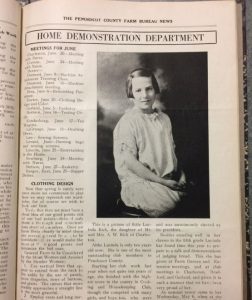 The Cooking and Housekeeping Champion of 1929, Lucinda Rich of Charleston, Wayne Rich’s cousin, was a stand-out too! She was 10 when she joined 4-H in 1924. She made such a splash in her first year that the county 4-H Staff included her photo and a few paragraphs about her in their May, 1925 edition of the Penobscot County Farm Bureau News (v6, #2, p3).
The Cooking and Housekeeping Champion of 1929, Lucinda Rich of Charleston, Wayne Rich’s cousin, was a stand-out too! She was 10 when she joined 4-H in 1924. She made such a splash in her first year that the county 4-H Staff included her photo and a few paragraphs about her in their May, 1925 edition of the Penobscot County Farm Bureau News (v6, #2, p3).
In the article they say that even though she is just 10 years old, “She is one of the most outstanding club members in Penobscot County.” High praise! Here’s why. “…last year (her FIRST year in 4-H) …she finished with the highest score in the county in Cooking and Housekeeping Club, though she competed with many girls, and boys too, who were years older than she, none who were as young.” Unanimously elected as President of the club in 1925, and “…standing well in her classes in the fifth grade,” she was a stand-out indeed! She even prepared a talk and demonstration on judging bread which she presented, according to the article, “…at Farm Bureau and Extension meetings, and at club meetings in Charleston, Bradford, and Garland, and giving it in such a manner that we have been very proud of her.”
She was only 13 when Maine asked her to represent the state as one of the four delegates sent by Maine to the 1927 National 4-H Club Camp, the Camp’s inaugural year! Of course, upon selection, notice was made of this accomplishment in the April 1927 edition of Echoes from Clubdom, (v9, #10, pages 3 & 4). After noting the accomplishments noted above, it went on saying, “Again in 1926 she won first honors in sewing and in pig projects and was a member of the demonstration team for her club. Already this year she has practically completed all the requirements for cooking and housekeeping work project.” And then they added, “Rather interesting sidelight is that Lucinda has attended nearly every club meeting since joining in 1924.”
Her three fellow delegates that year were Norman Hamlin, Andrew Sawtelle, and Lucille Parker. According to that same Echoes from Clubdom article, Norman Hamlin, also a four year member, was from Turner in Twin County. Having won the chicken project State Championship in 1925 and 1926 he was looking to win it again in 1927. However, as we already know, along came Watson! Hamlin’s goal was to study agriculture at the University of Maine. No word on if he did but we assume so.
Andrew Sawtelle was from East Wilton in Franklin County. He’d been in 4-H for five years. Over those years he excelled at potato growing, sweet corn, and gardening, winning county potato champion in 1926. Being almost continually on the Honor Roll, popular among his fellow students and manager of the school football team round out his resume!
Lucille Parker hailed from Dover-Foxcroft in Piscataquis County. Lucille, 16 in 1927, was the longest tenured of the group having been in 4-H for six years, a member of the Over The Top 4-H Club of West Dover. Canning, sewing, cooking, and housekeeping, and, in 1926, pigs were her projects. Because of all the prizes she’d won, the article ends saying that was, “…a good indication of the fine quality of workmanship that she has been doing.” Go Lucille!
But we were talking about Lucinda. At 18 in 1932, while serving as both Club Leader and Member of the Charleston 4-H Club, Lucinda Rich earned the title State 4-H Canning Champion. She graduated from Higgins Classical Institute in 1933 and entered classes at the University of Maine studying Home Economics. In 1936 the Maine State Federation of Farm Bureaus established a scholarship at the University of Maine for College of Agriculture students and gave the first one to Lucinda Rich. In 1937 she graduated with distinction from the University of Maine holding a BS in Home Economics.
Shortly thereafter Lucinda joined the Extension staff of Knox-Lincoln County as the 4-H Club Agent. In 1940 she became the K-L County Home Demonstration Agent and continued in that role until shortly after her marriage to Clarence E (Bob) Waterman. They were married January 10, 1943.
Together they raised three children, Rebecca, Robert, and Sally. In 1963 Lucinda became a high school teacher. She taught at Camden High School and Camden-Rockport High School through 1970.
On Thanksgiving Day, November 27, 2003, Lucinda Rich Waterman passed away, a true champion for all of her 89 years.
As understanding of the science of youth development progressed, however, less emphasis was placed on head to head competitions and more emphasis was given to recognizing excellence of one’s own efforts. Traditional State Championships were discontinued in 1939, replaced by recognition being given to 4‑H’ers who excelled not only in their 4-H projects but in all aspects of 4-H. By 1941 the only “state championships” awarded were those supported by national donors, the selection process primarily serving as a means of identifying delegates for national 4-H experiences. Eleven such project-specific “champions” were named in 1941 — six members were designated to attend National 4-H Club Congress in Chicago and two delegates were designated to attend the National Dairy Show in Memphis, TN, while two others received gold watches and one received a gold medal.
And so it has continued into recent times. Through this blog you have already met Kathy Watier, Sarah Stoodley, Betsy Carroll, and Aaron Carroll, true “champions” of Maine 4-H from the 1990s even if we didn’t call them that! There were many “Champions” in the 1990s including “super” leaders such as Michelle Fogg of Waldo County; brothers J.J. and Travis Averill, Franklin Co; Jana Hawes and Alana Burns, Knox-Lincoln Co; Mark Benware (he wanted to become an airline pilot. I wonder if he ever did.), Cumberland Co; and Ortencia Arellano, Franklin Co.
Ortencia. What a strong LEADER! Ortencia and Jana were President and Vice President respectively of the 1998 State 4-H Teen Council; my last year working with that group. Both of them (well, all of them REALLY, listed here or not) had tremendous potential for success!
And, of course, now I am in BIG trouble for naming names because this list of “champions” from the 1990s only scratches the surface! It could grow to be quite long! For example, take Cumberland County’s Sarah Clark. She now sits as a member of the State 4-H Staff but we call her Sarah Sparks today!
Speaking of today, here is a photo of some of Maine’s NEWEST 4-H Champions — 2017 recipients of Maine 4-H Foundation Scholarships, many of whom have already been to, or will soon be attending, National 4-H Conference and/or National 4-H Congress. True Leaders ALL!
In a report on Extension in Maine from 1910 to 1950, Clarence Day, by then Extension Editor Emeritus, wrote in 1957, “…during the 1930s 4-H club work became mature (and)…won a sure place in the educational system of the nation….”
So the non-formal educational process that in the beginning selected Champions from amongst its participants, grew up to itself become a CHAMPION — the Champion of Education that it is today. Again quoting Day from his 1957 report, he suggests that the most lasting rewards gained through 4-H, “…are to be found in the growth and development of the boys and girls themselves — in the knowledge that they learn and in the skills that they acquire in their endeavor to make their best better.”
In 2017, I couldn’t say it any better myself.
Don’t miss your December 4-H Fix! Due to go live on December 15, it will be a noteworthy way to end the year! It’s all about 4-H SINGING!
Were you a 4-H Member?
 UMaine 4-H wants to hear your story. Please take a moment to fill out our short form and Tell Us Your Story!
UMaine 4-H wants to hear your story. Please take a moment to fill out our short form and Tell Us Your Story!
Click here to learn how to support UMaine 4-H.
University of Maine Cooperative Extension conducts the state’s most successful out-of-school youth educational program through 4-H, a youth development program that has been empowering young people in Maine to reach their full potential since 1913.

